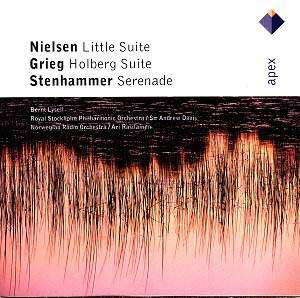The real attraction on this disc is the remarkable
Serenade by Wilhelm Stenhammar. If you don’t yet know his music,
I recommend you start here, with this truly beautiful and strongly individual
work. There are echoes of many composers – Sibelius in the sudden moments
of hushed mystery, Brahms in the rich writing for lower strings and
chorale-like melodies, Richard Strauss in the splendidly ripe orchestration
replete with horn fanfares - yet Stenhammar has a powerful musical personality
all of his own.
The work is essentially a symphony, which the composer
worked on from 1907 to its première in 1914 – though even after
that he revised it, reducing the number of movements from six to five.
Sir Andrew Davis and the Royal Stockholm Philharmonic give it a splendid
performance which brings out the work’s many beauties, and, vitally,
its sense of fantasy. The important solo violin part is beautifully
projected by Bernt Lysell.
The first movement is spacious, with a strong open-air
feel to it; in fact a magical sense of
the outdoors pervades most of the work. The spirit of Dvořák seems
to inhabit the lovely Canzonetta, while the playful yet
explosive Scherzo certainly brings Sibelius to mind – even some of the
harmonies have a distinctly Sibelian colour to them.
Though technically the four movements are separate,
there is a psychological and musical link from one to the next. So the
restless energy of the scherzo gives way to the thoughtful and emotionally
intense Notturno, with its poetic woodwind writing. A quiet horn
solo leads us into the ebullient finale, which is as full as the rest
of the work of effortless melodic invention. The throw-away ending is
a delight.
Grieg’s early essay in Neo-classicism, the Holberg
Suite, is given an enjoyable and accomplished performance by the
Helsinki Strings under Szilvay, with, to English ears an unmistakable
hint of the Sailor’s Hornpipe to spice up the final Rigaudon.
Nielsen’s Little Suite, written when he was in his early 20s
and still ‘a certain Mr. Nielsen whom nobody knows’ as a newspaper article
announcing the concert described him, completes the disc interestingly
enough. Though not a remarkable work, it has charm; its most attractive
movement being the central Intermezzo, with reminiscences of
Grieg’s Anitra’s Dance. The Norwegian Radio Orchestra Strings
under Ari Rasilainen give a stylish performance.
Another excellent value disc from Apex, worth having
for the wonderful Stenhammar alone.
Gwyn Parry-Jones


![]() See
what else is on offer
See
what else is on offer 